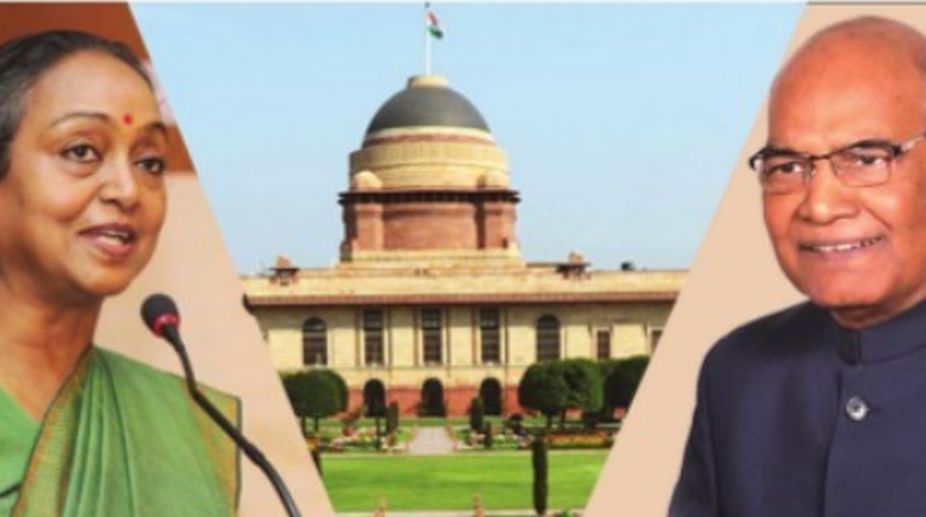Two Telangana youths hung upside down on suspicion of theft
In a shocking incident, two youths, including a Dalit, were hung upside down and tortured on the suspicion of theft…

It is now official that there will be a contest for presidential elections scheduled for July 17 as both the ruling National Democratic Alliance and the United Progressive Alliance have announced their nominees. Both have chosen Dalit candidates to score a political point and made it a Dalit versus Dalit contest.
This is not the first time a contest is taking place nor the first time the caste card has been played. There have been interesting contests since VV Giri, an Independent, won in 1969 supported by Indira Gandhi defeating N Sanjiva Reddy, the official Congress candidate. Since then there have been token contests. Even in 2007, when then Vice-president Bhairon Singh Shekhawat contested as an Independent, the ruling UPA pulled out another Shekhawat – Pratibha Patil – from its hat and the latter won.
The NDA has chosen Ramnath Kovind, a low-profile Dalit leader from Kanpur as its presidential nominee. It is for the first time the BJP is in a position to elect its own candidate since independence. If elected, he will be the second Dalit president after KR Narayanan. Prime Minister Narendra Modi has deliberately chosen a non-controversial candidate to get votes from fence sitters. He was the Bihar Governor after Modi took over and a two time Rajya Sabha member. He has RSS connections and led the party’s scheduled caste cell. A sober man, Kovind is a lawyer and had also worked in Prime Minister Morarji Desai's office as his aide earlier. He has a good track record.
Advertisement
The UPA has fielded former Speaker Meira Kumar. She has political pedigree as she is the daughter of the tall Dalit leader late Babu Jagjivan Ram. A Foreign Service officer who joined the Congress in 1985 she has seen ups and downs and was considered even in 2012 for the presidential post. But ultimately the Congress chose Pranab Mukherjee who won the race. Even this time, the UPA considered four names – former Union Minister Sushil Kumar Shinde, Bhalchandra Mungekar, Prakash Ambedkar and Meira Kumar and the consensus was on Meira Kumar. This opposition claims that a contest will symbolise “a battle of ideologies”.
Although the opposition showed its political clout by getting 17 non-BJP parties to choose Meira Kumar, it will only be a token contest. The Electoral College to choose the president consists of all Members of Parliament and Members of all Legislative Assemblies. The value of each vote is calculated according to a special formula that depends on the population of the constituency of the elected representative. The total strength is fixed at 10,98,882 votes. The candidate, who crosses the halfway-mark of 5,49,442 will be declared as the winner. With its formidable presence, the BJP’s electoral votes, along with allies, is only 24,522 short of what is required. The NDA stands united and is ready for a show of strength. While its ally Shiv Sena played ducks and drakes initially it has fallen in line after Kovind’s name was announced. The BJP has already mobilised the support of the JD (U), AIADMK, TRS, YSR Congress and the BJD. Other fence sitters may also support. All this will be about 60 per cent of the votes required for a win.
On the other hand, there are already cracks within the Opposition as some like the Samajwadi party and the JD (U) have expressed support for the NDA Presidential nominee. The problem for both NDA and UPA is to keep the flock together. The UPA is more vulnerable in this regard because more opposition parties could change their position any time between now and the polling date. Some like the BSP were wavering when the NDA first announced the name of Kovind but now that the opposition also has decided on a Dalit, BSP chief Mayawati has declared “the UPA nominee for President's post Meira Kumar is more capable and popular than NDA candidate.” It was the fear of getting decimated by the BJP that has prompted these diverse leaders to put aside their egos and explore the possibility of a joint candidate.
Kovind’s nomination has exposed the division in the opposition ranks as Nitish Kumar has his own political calculations and is keen on supporting Kovind. By choosing Meira Kumar the UPA has put Nitish Kumar in an embarrassing position because she is from Bihar. RJD chief Lalu Prasad Yadav has declared that she is both Jagjivan Ram’s daughter and Bihar’s daughter. Even earlier Nitish had supported the demonetisation move of Modi when the opposition opposed it. Nitish Kumar relies heavily on Dalit support.
Meira Kumar has acknowledged that it is a battle of ideologies. The opposition has so far been using the communal/secular divide but has not succeeded in checking Modi. It is clear that the opposition has to change the narrative and it is yet to decipher what it could be. As of now, unless something dramatic happens, the election of Kovind is more or less certain and the Dalit President may soon be the new occupant of Rashtrapathi Bhavan.
Kovind began well with his sober statement to the media after filing his nomination papers when he said, “Ever since I became governor, I don’t belong to any political party. The post of President is above party politics. I am thankful to everybody for their support.” He assured that, “I will do my best to maintain dignity of the high office of the President.” Let us hope he will keep his promise and not become a Fakruddin Ali Ahmed.
Advertisement